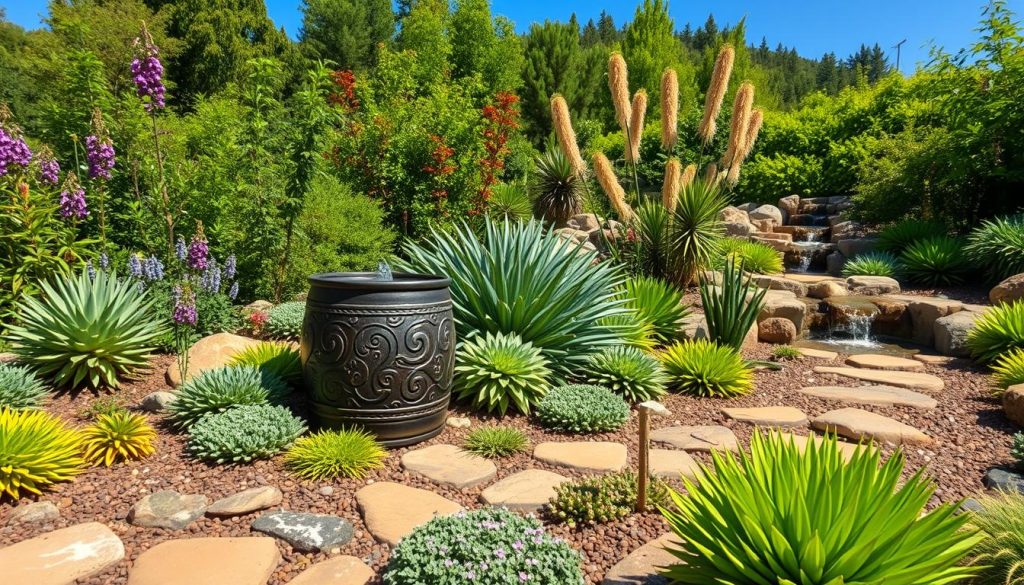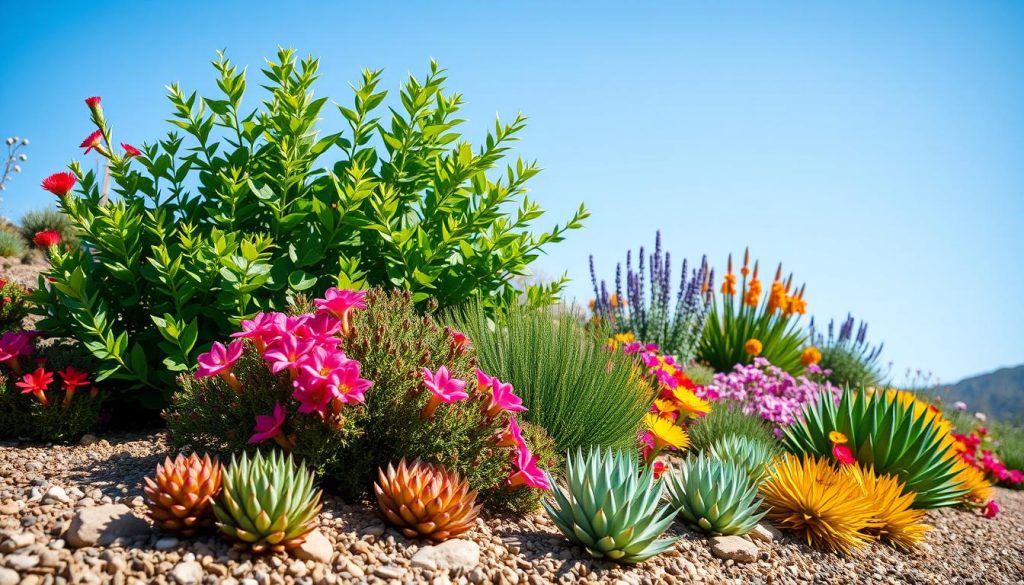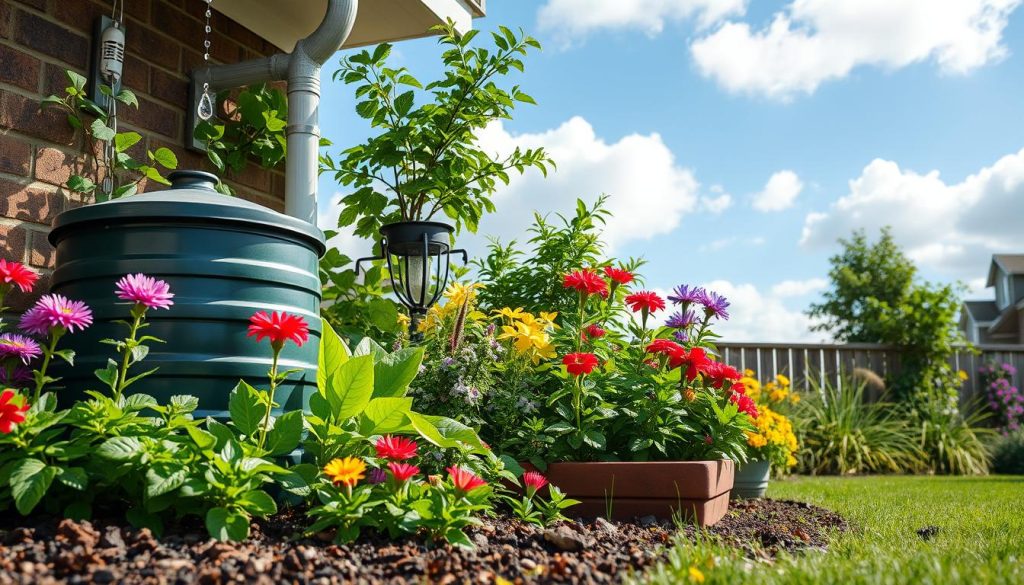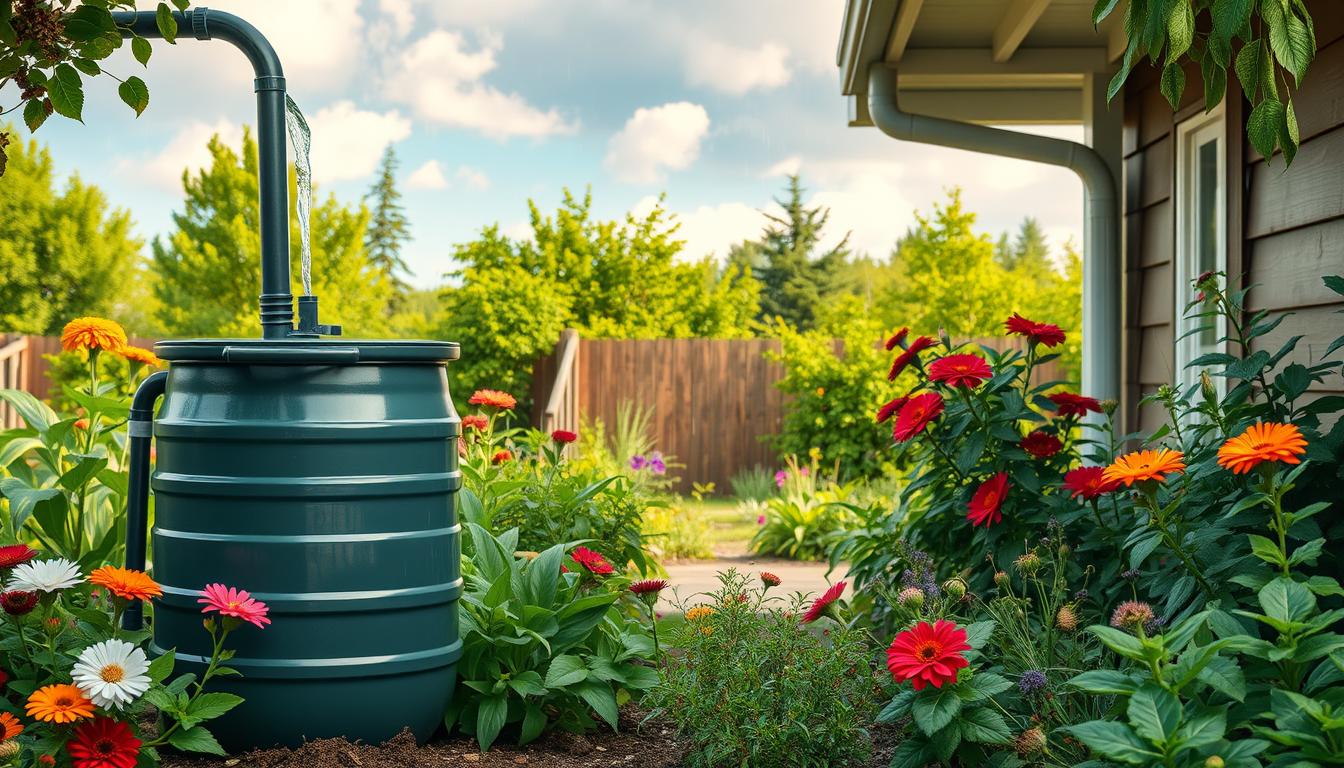I’m excited to share my experience with rainwater harvesting for gardens. It has turned my outdoor space into a lush oasis. It also helps save water, which is good for the environment and my wallet.
The United States Environmental Protection Agency says collecting rainwater cuts down on stormwater runoff. It also lowers the need for drinking water. This makes rainwater harvesting key for gardens.
My journey has shown me the value of rainwater harvesting. It lowers water bills, cuts down on carbon footprint, and supports sustainable gardening. In this article, I’ll share how to make a lush, water-saving garden using rainwater harvesting. I’ll also talk about the benefits of saving water and gardening sustainably.
What is Rainwater Harvesting?
Rainwater harvesting is a simple way to collect rainwater for plants. It helps reduce the need for potable water. As someone who loves eco-friendly garden tips, I’ve found it’s great for a sustainable garden. The EPA says a single inch of rain on a 1,000-square-foot roof can give over 600 gallons of water.
Starting with a rain barrel is a good first step. It’s a green way to water your plants and cuts down on stormwater runoff. Here are some benefits of collecting rainwater:
- Reduced water bills
- Decreased stormwater runoff
- Increased water conservation
Using rainwater harvesting makes your garden more sustainable. It’s not just good for the environment; it also makes your garden look great. Stay tuned for more eco-friendly garden tips and tricks!
How to Get Started with Rainwater Harvesting
To start with rainwater harvesting, first learn about its benefits. It helps save water and money. It also makes gardening more eco-friendly and affordable.
Essential Tools and Materials Needed
The National Association of Landscape Professionals suggests using a first flush device. This keeps debris out of the water. You’ll need:
- Rain barrels or tanks
- Downspouts and gutters
- First flush devices
- Screening systems to keep out debris
Planning Your Rainwater Collection System
Plan your system based on your roof size and local rainfall. Think about how you’ll use the water. This helps you choose the right size and location for your rain barrel. It ensures your system works well and saves water.

Installing a Rain Barrel: Step-by-Step Guide
To start collecting rainwater for your garden, you’ll need a rain barrel. It’s a simple and cost-effective way to harvest rainwater. Choose a spot that is level and near a downspout.
A rain barrel is key for any eco-friendly gardener. It helps you save water and make your garden more sustainable. Here are some tips for installing your rain barrel:
Choosing the Right Location
Find a spot that’s easy to reach and can hold a rain barrel. Make sure it’s level to avoid tipping. The University of California, Davis, suggests using a screen to keep out mosquitoes and debris.
Connecting to Downspouts
Connecting your rain barrel to a downspout is easy. You can buy a downspout diverter to direct water into the barrel. This way, you can collect rainwater and reduce storm drain water flow.
Maintaining Your Rain Barrel
To keep your rain barrel in good shape, clean and inspect it regularly. Check for debris or mosquito larvae and empty it if needed. By following these tips, you can have a sustainable and thriving garden.
The Best Plants for a Water-Wise Garden
Creating a water-wise garden starts with the right plants. I’ve learned that native plants and drought-resistant species are key. Using water-efficient landscaping also helps save water.
The Lady Bird Johnson Wildflower Center says native plants like succulents and cacti are great. They need less water, fitting well into a water-wise garden. Other good plants include:
- Lavender
- Rosemary
- Thyme
- Yarrow
Native plants are good for the environment. They need less fertilizer and pesticides. Water-efficient landscaping is also important for saving water and reducing waste.

Choosing the right plants and using sustainable practices can make a beautiful garden. Make sure to pick plants that fit your climate. Don’t be afraid to try different plants to find the best for your garden.
Maximizing the Use of Collected Rainwater
To get the most out of your collected rainwater, it’s key to use it well in your garden. A drip irrigation system is a great choice. It sends water straight to the roots, cutting down on evaporation and runoff. This method is good for the environment and saves water, making it perfect for gardening with rainwater.
Efficient Watering Techniques
Some smart ways to water include:
- Watering in the early morning or evening to cut down on evaporation
- Using a soaker hose to water plants at their roots
- Avoiding too much water to prevent waste and soil erosion
Using these methods, you can use your rainwater wisely. You’ll save on water bills and have a greener garden.
Creating a Rainwater Irrigation System
Setting up a rainwater irrigation system is easy. You’ll need a timer and a pressure regulator. Follow a few steps to create a system that maximizes your rainwater use. This will make your garden healthier and more sustainable.
Common Challenges and Solutions
Exploring rainwater harvesting for gardens, I’ve found some common challenges. Dealing with mosquitoes and pests is a big one. They can breed in standing water. To fix this, using mosquito nets in rain barrels is a good idea, as the CDC suggests.
This simple step can lower the risk of diseases and keep your garden water-saving efforts going.
Another issue is fixing your rainwater harvesting system. It’s key to check for leaks and clean the screen to avoid clogs. Here’s how to do it:
- Check the system for any blockages or leaks
- Clean the screen and other components regularly
- Use a first flush device to divert debris and contaminants
By following these steps, you can make a water-saving garden. It will not only save water but also help the environment. Always focus on saving water and find ways to improve your rainwater system.

Enhancing Your Garden’s Ecosystem
To make your garden thrive, use eco-friendly tips and water-saving landscaping. Harvesting rainwater is a great way to do this. It cuts down on your water bill and makes gardening more sustainable.
The National Wildlife Federation says native plants are key to attracting wildlife. Plants like coneflowers, black-eyed susans, and milkweed are perfect. They help make your garden a home for birds and butterflies.
Creating a Biodiverse Space with Rainwater
- Use native plants to attract local wildlife
- Avoid using pesticides, which can harm beneficial insects and animals
- Incorporate a variety of plants that provide food and shelter for different species
By using these tips and saving water, you can make your garden a haven for wildlife. Harvesting rainwater is a smart choice for a greener garden and a beautiful outdoor space.
Frequently Asked Questions About Rainwater Harvesting
Starting your rainwater harvesting journey for your garden might raise some questions. Let’s tackle a few common ones to help you begin well.
Clarifying Legal Aspects of Rainwater Collection
First off, let’s talk about the legal side of rainwater harvesting. In most of the United States, collecting rainwater for your garden is okay. But, it’s smart to check with your local government to see if there are any rules in your area. This way, you can enjoy sustainable gardening while following the law.
Tips for Beginners and Experienced Gardeners
Whether you’re new or have been gardening for a while, there’s always more to learn. Beginners might want to start with a simple rain barrel system. As you get more comfortable, you can look into bigger projects. Experienced gardeners can try new things to make their rainwater system even better.
I hope these answers help you feel ready to use rainwater harvesting in your garden. If you have more questions, feel free to ask. I love sharing tips for a beautiful, water-saving garden.

